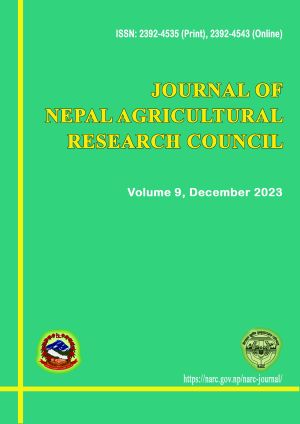Growth and Yield Traits of Potato Genotypes Grown under Different Cultivation Practices in Dailekh, Nepal
DOI:
https://doi.org/10.3126/jnarc.v9i1.61588Keywords:
Drought, genotypes, partial irrigation, straw mulching, yieldAbstract
Variable rainfall and recurrent drought in spring season limit the potato production at Dailekh. To address this problem, a two-year (2019-2020) field experiment was conducted at HRS, Dailekh to investigate 12 potato genotypes (T-304347.6, T-393371.58, T-304350.1, T-304351.109, T-302498.7, T-304405.47, T-303381.3, T-396311.1, T-397029.1, T-304368.46, Desiree and Cardinal) along with different growing practices (Partial Irrigation (PI), rain-fed and straw mulch) for their growth, and yield traits. The experiment was laid out in split-plot design, where three different growing practices were allotted as main plot and 12 potato genotypes were placed as sub-plot treatment, and it was replicated three times. The combined analysis revealed that growing practices significantly affected the ground cover, plant height, stem number, marketable tuber number and weight, and yield. Potato genotypes showed the significant effect on all the plant and yield traits. Straw mulch produced 28.7% and 21.6% higher marketable tuber yield than PI and rain-fed potato, respectively. Genotypes T-304351.109 and T-397029.1 imparted 22.9% and 17.4% higher marketable tuber yield than Desiree, check variety, respectively. Therefore, growing of high yielding genotypes T-304351.109 and T-397029.1 along with straw mulch can be the best option to increase the potato productivity at rain-fed condition of Dailekh.
Downloads
Downloads
Published
How to Cite
Issue
Section
License
Copyright (c) 2023 Nepal Agricultural Research Council

This work is licensed under a Creative Commons Attribution-NonCommercial 4.0 International License.
This license enables reusers to distribute, remix, adapt, and build upon the material in any medium or format for noncommercial purposes only, and only so long as attribution is given to the creator.




